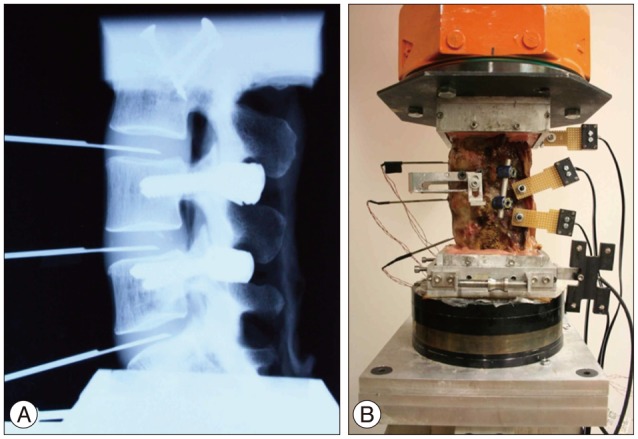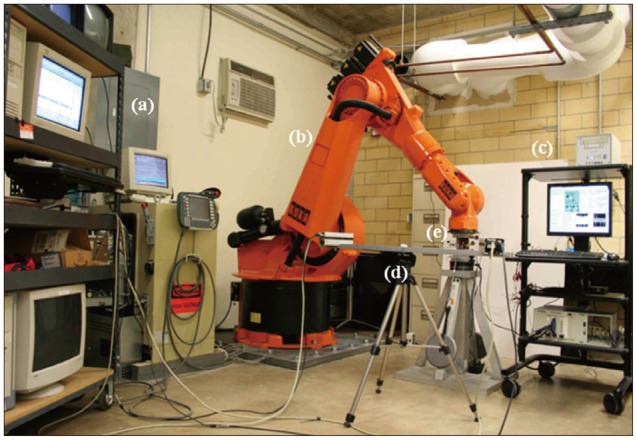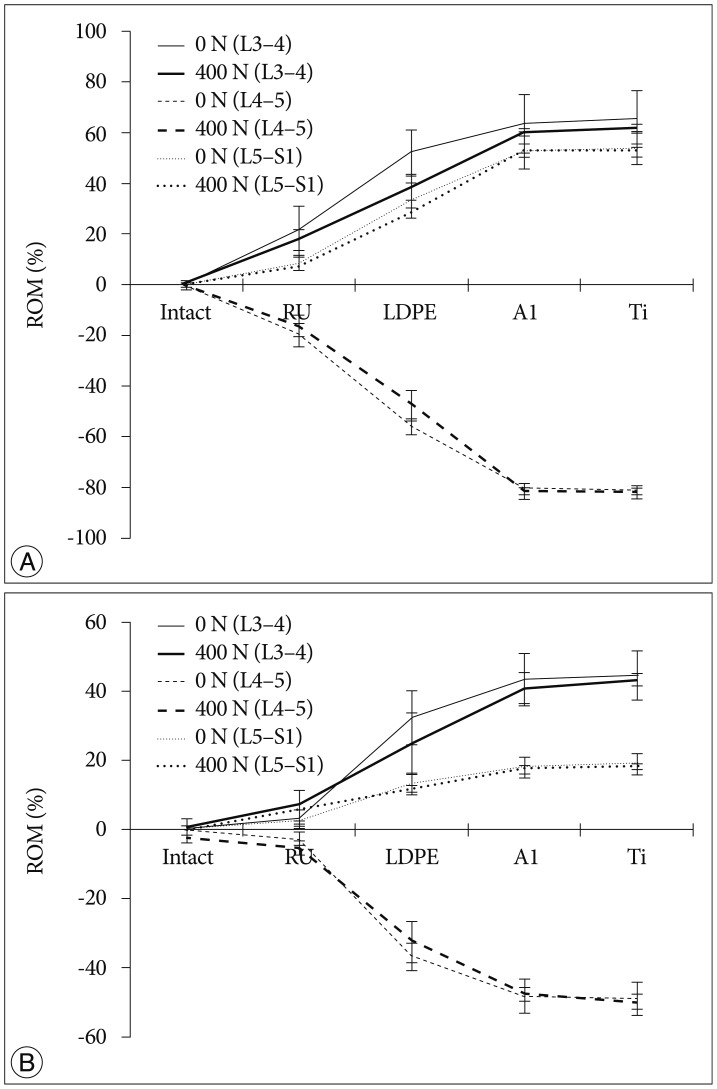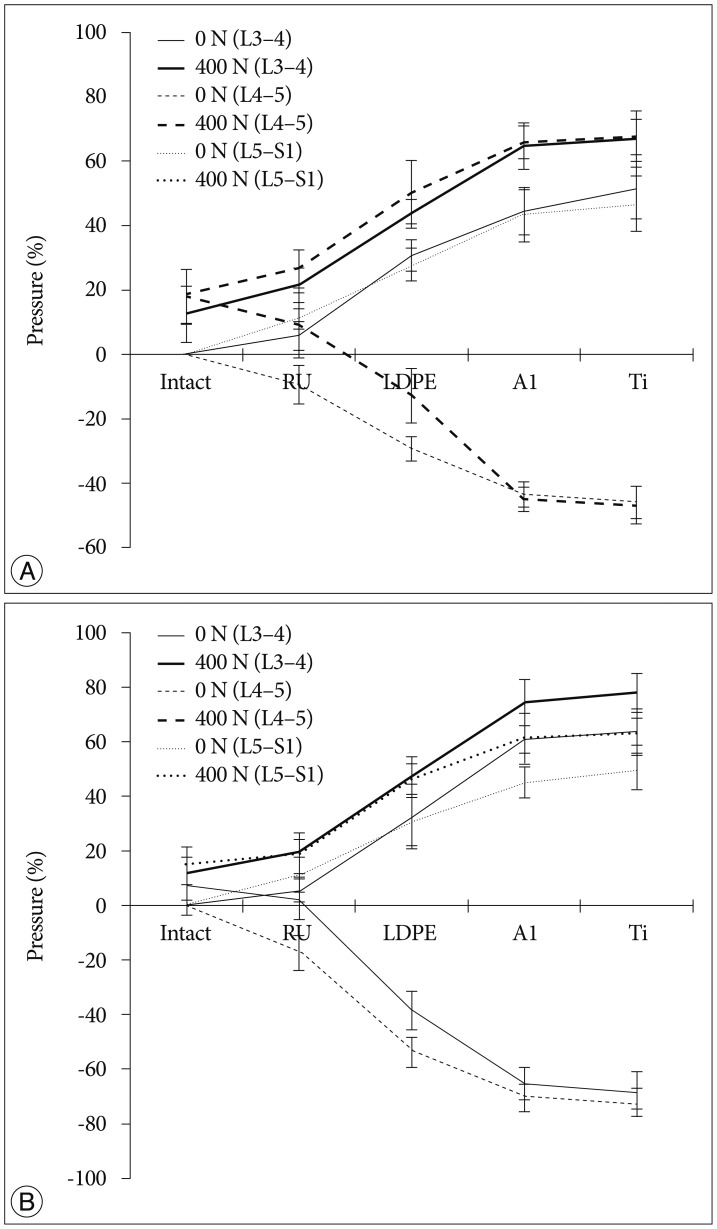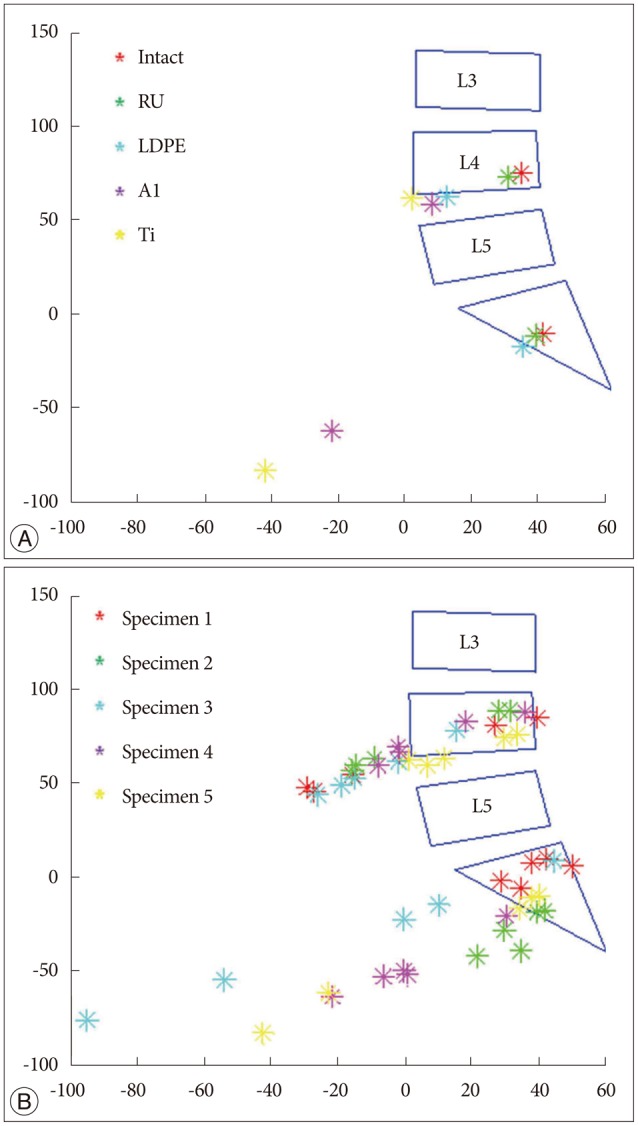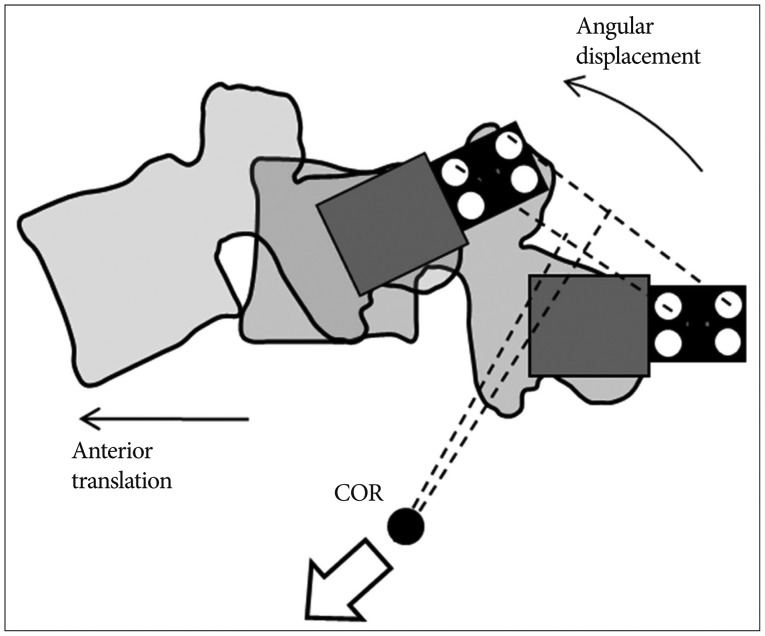J Korean Neurosurg Soc.
2015 Nov;58(5):412-418. 10.3340/jkns.2015.58.5.412.
Effect of Device Rigidity and Physiological Loading on Spinal Kinematics after Dynamic Stabilization : An In-Vitro Biomechanical Study
- Affiliations
-
- 1Department of Neurosurgery, Baylor College of Medicine, Houston, TX, USA.
- 2Department of Medical Biotechnology, Dongguk University, Seoul, Korea.
- 3Department of Neurosurgery, Ewha Womans University College of Medicine, Seoul, Korea. drcho@ewha.ac.kr
- KMID: 2191405
- DOI: http://doi.org/10.3340/jkns.2015.58.5.412
Abstract
OBJECTIVE
To investigate the effects of posterior implant rigidity on spinal kinematics at adjacent levels by utilizing a cadaveric spine model with simulated physiological loading.
METHODS
Five human lumbar spinal specimens (L3 to S1) were obtained and checked for abnormalities. The fresh specimens were stripped of muscle tissue, with care taken to preserve the spinal ligaments and facet joints. Pedicle screws were implanted in the L4 and L5 vertebrae of each specimen. Specimens were tested under 0 N and 400 N axial loading. Five different posterior rods of various elastic moduli (intact, rubber, low-density polyethylene, aluminum, and titanium) were tested. Segmental range of motion (ROM), center of rotation (COR) and intervertebral disc pressure were investigated.
RESULTS
As the rigidity of the posterior rods increased, both the segmental ROM and disc pressure at L4-5 decreased, while those values increased at adjacent levels. Implant stiffness saturation was evident, as the ROM and disc pressure were only marginally increased beyond an implant stiffness of aluminum. Since the disc pressures of adjacent levels were increased by the axial loading, it was shown that the rigidity of the implants influenced the load sharing between the implant and the spinal column. The segmental CORs at the adjacent disc levels translated anteriorly and inferiorly as rigidity of the device increased.
CONCLUSION
These biomechanical findings indicate that the rigidity of the dynamic stabilization implant and physiological loading play significant roles on spinal kinematics at adjacent disc levels, and will aid in further device development.
Keyword
MeSH Terms
Figure
Reference
-
1. Ahn YH, Chen WM, Lee KY, Park KW, Lee SJ. Comparison of the load-sharing characteristics between pedicle-based dynamic and rigid rod devices. Biomed Mater. 2008; 3:044101. PMID: 19029615.
Article2. Andersson GB. Epidemiological features of chronic low-back pain. Lancet. 1999; 354:581–585. PMID: 10470716.
Article3. Bellini CM, Galbusera F, Raimondi MT, Mineo GV, Brayda-Bruno M. Biomechanics of the lumbar spine after dynamic stabilization. J Spinal Disord Tech. 2007; 20:423–429. PMID: 17970182.
Article4. Chen CS, Cheng CK, Liu CL, Lo WH. Stress analysis of the disc adjacent to interbody fusion in lumbar spine. Med Eng Phys. 2001; 23:483–491. PMID: 11574255.
Article5. Cheng BC, Gordon J, Cheng J, Welch WC. Immediate biomechanical effects of lumbar posterior dynamic stabilization above a circumferential fusion. Spine (Phila Pa 1976). 2007; 32:2551–2557. PMID: 17978653.
Article6. Eck JC, Humphreys SC, Hodges SD. Adjacent-segment degeneration after lumbar fusion: a review of clinical, biomechanical, and radiologic studies. Am J Orthop (Belle Mead NJ). 1999; 28:336–340. PMID: 10401898.7. Evans JH. Biomechanics of lumbar fusion. Clin Orthop Relat Res. 1985; (193):38–46. PMID: 3882295.
Article8. Freudiger S, Dubois G, Lorrain M. Dynamic neutralisation of the lumbar spine confirmed on a new lumbar spine simulator in vitro. Arch Orthop Trauma Surg. 1999; 119:127–132. PMID: 10392504.
Article9. Fritzell P, Hägg O, Wessberg P, Nordwall A. Swedish Lumbar Spine Study Group. 2001 Volvo Award Winner in Clinical Studies : lumbar fusion versus nonsurgical treatment for chronic low back pain : a multicenter randomized controlled trial from the Swedish Lumbar Spine Study Group. Spine (Phila Pa 1976). 2001; 26:2521–2532. discussion 2532-2534PMID: 11725230.
Article10. Gere JM, Goodno BJ. Mechanics of Materials. ed 8. Stanford: Cengage Learning;2012. p. 1089–1094.11. Gertzbein SD, Holtby R, Tile M, Kapasouri A, Chan KW, Cruickshank B. Determination of a locus of instantaneous centers of rotation of the lumbar disc by moiré fringes. A new technique. Spine (Phila Pa 1976). 1984; 9:409–413. PMID: 6474254.
Article12. Goel VK, Panjabi MM, Patwardhan AG, Dooris AP, Serhan H;. Test protocols for evaluation of spinal implants. J Bone Joint Surg Am. 2006; 88(Suppl 2):103–109. PMID: 16595454.
Article13. Goto K, Tajima N, Chosa E, Totoribe K, Kubo S, Kuroki H, et al. Effects of lumbar spinal fusion on the other lumbar intervertebral levels (three-dimensional finite element analysis). J Orthop Sci. 2003; 8:577–584. PMID: 12898313.
Article14. Kim HJ, Bak KH, Chun HJ, Oh SJ, Kang TH, Yang MS. Posterior interspinous fusion device for one-level fusion in degenerative lumbar spine disease : comparison with pedicle screw fixation - preliminary report of at least one year follow up. J Korean Neurosurg Soc. 2012; 52:359–364. PMID: 23133725.
Article15. Kim YS, Zhang HY, Moon BJ, Park KW, Ji KY, Lee WC. Nitinol spring rod dynamic stabilization system and Nitinol memory loops in surgical treatment for lumbar disc disorders: short-term follow up. Neurosurg Focus. 2007; 22:E10.
Article16. Lee CK. Accelerated degeneration of the segment adjacent to a lumbar fusion. Spine (Phila Pa 1976). 1988; 13:375–377. PMID: 3388124.
Article17. Lee CK, Langrana NA. Lumbosacral spinal fusion. A biomechanical study. Spine (Phila Pa 1976). 1984; 9:574–581. PMID: 6495027.
Article18. Meyers K, Tauber M, Sudin Y, Fleischer S, Arnin U, Girardi F, et al. Use of instrumented pedicle screws to evaluate load sharing in posterior dynamic stabilization systems. Spine J. 2008; 8:926–932. PMID: 18037350.
Article19. Niosi CA, Wilson DC, Zhu Q, Keynan O, Wilson DR, Oxland TR. The effect of dynamic posterior stabilization on facet joint contact forces : an in vitro investigation. Spine (Phila Pa 1976). 2008; 33:19–26. PMID: 18165744.
Article20. Niosi CA, Zhu QA, Wilson DC, Keynan O, Wilson DR, Oxland TR. Biomechanical characterization of the three-dimensional kinematic behaviour of the Dynesys dynamic stabilization system : an in vitro study. Eur Spine J. 2006; 15:913–922. PMID: 16217663.
Article21. Panjabi M, Dvorak J, Duranceau J, Yamamoto I, Gerber M, Rauschning W, et al. Three-dimensional movements of the upper cervical spine. Spine (Phila Pa 1976). 1988; 13:726–730. PMID: 3194778.
Article22. Panjabi MM. Centers and angles of rotation of body joints : a study of errors and optimization. J Biomech. 1979; 12:911–920. PMID: 528549.
Article23. Patwardhan AG, Carandang G, Ghanayem AJ, Havey RM, Cunningham B, Voronov LI, et al. Compressive preload improves the stability of anterior lumbar interbody fusion cage constructs. J Bone Joint Surg Am. 85-A; 12:1749–1756.
Article24. Pearcy M, Portek I, Shepherd J. Three-dimensional x-ray analysis of normal movement in the lumbar spine. Spine (Phila Pa 1976). 1984; 9:294–297. PMID: 6374922.
Article25. Pearcy MJ, Bogduk N. Instantaneous axes of rotation of the lumbar intervertebral joints. Spine (Phila Pa 1976). 1988; 13:1033–1041. PMID: 3206297.
Article26. Pearcy MJ, Tibrewal SB. Lumbar intervertebral disc and ligament deformations measured in vivo. Clin Orthop Relat Res. 1984; (191):281–286. PMID: 6499321.
Article27. Sato K, Kikuchi S, Yonezawa T. In vivo intradiscal pressure measurement in healthy individuals and in patients with ongoing back problems. Spine (Phila Pa 1976). 1999; 24:2468–2474. PMID: 10626309.
Article28. Schlegel JD, Smith JA, Schleusener RL. Lumbar motion segment pathology adjacent to thoracolumbar, lumbar, and lumbosacral fusions. Spine (Phila Pa 1976). 1996; 21:970–981. PMID: 8726202.
Article29. Schmoelz W, Huber JF, Nydegger T, Claes L, Wilke HJ. Influence of a dynamic stabilisation system on load bearing of a bridged disc : an in vitro study of intradiscal pressure. Eur Spine J. 2006; 15:1276–1285. PMID: 16429291.
Article30. Schmoelz W, Huber JF, Nydegger T, Dipl-Ing , Claes L, Wilke HJ. Dynamic stabilization of the lumbar spine and its effects on adjacent segments : an in vitro experiment. J Spinal Disord Tech. 2003; 16:418–423. PMID: 12902959.
Article31. Shin DS, Lee K, Kim D. Biomechanical study of lumbar spine with dynamic stabilization device using finite element method. Computer-Aided Des. 2007; 39:559–567.
Article32. Swanson KE, Lindsey DP, Hsu KY, Zucherman JF, Yerby SA. The effects of an interspinous implant on intervertebral disc pressures. Spine (Phila Pa 1976). 2003; 28:26–32. PMID: 12544951.
Article33. White AA, Panjabi MM. Clinical biomechanics of the spine. ed 2. Philadelphia: Lippincott;1990. p. 109–112.34. Xu HZ, Wang XY, Chi YL, Zhu QA, Lin Y, Huang QS, et al. Biomechanical evaluation of a dynamic pedicle screw fixation device. Clin Biomech (Bristol, Avon). 2006; 21:330–336.
Article
- Full Text Links
- Actions
-
Cited
- CITED
-
- Close
- Share
- Similar articles
-
- Biomechanics of the Spine
- Biomechanical Study about Difference between Stainless Steel and Titanium Dynamic Hip Screws in Peritrochanteric Fractures of the Femur
- Overview of Various Measurement Tools for Shoulder Kinematics
- Stress Analysis of the Lumbar Spine under Dynamic Loading Condition with 3 - D Nonlinear Finite Element Model
- Late Complications of the Single Level 'Interspinous U' in Lumbar Spinal Stenosis with Mild Segmental Instability

